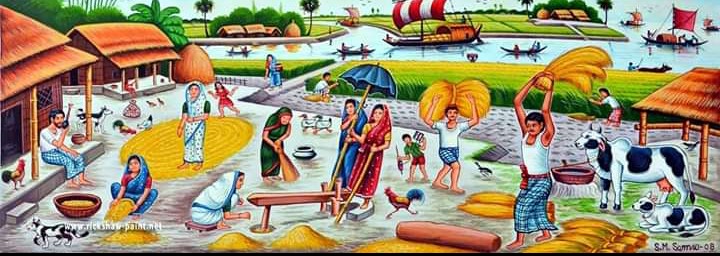Village fair

Village fair
Mela Abhaman is one of the cultural traditions of rural Bengal. The match with Bengali life is long overdue. This relationship is intense and spiritual. The intimate identity of Lake life and Lake culture is successfully revealed. Fairs are a source of endless joy in the lives of rural people. Fairs are held in Bangladesh on various occasions like Chaitrasankranti Mela, Baishakhi Mela, Poush Mela, Muharram Mela, Book Mela, Tree Mela etc. Rabindranath Tagore, a world poet, wrote in a prose essay about the fair: This fair invites outsiders into our country. In this festival, Palli spreads all your narrowness - this is the main occasion to open his heart to give and receive. Throughout the year, fairs are seen anywhere in the country. Fairs are organized on one occasion in one place. Behind the organization of the fair in the corner there are legends, in the miraculous corner there is the story of a legend or a saint, a fakir, a saint. Somewhere there is a fair for the Hindus on the occasion of Rath Yatra, Dolayatra, Punyasnan, Durga Puja etc. and on the occasion of Muharram of the Muslims. Usually the fairs of rural Bengal are held on the banks of the river, in the shade of huge boats or in the open desert. Whatever the occasion of the fair, the festival usually has a festive atmosphere. The fair grounds are abuzz with colorful outfits, noise all around, and strange sounds. The fair lasts for one to seven, eight, ten days or even months. The festive mood of the fair spread among the locals. Whatever the occasion of the fair, there are various products in the fair. The fair has a variety of household items, decorative items, children's and teenagers' pleasures, sports equipment and delicious food. The form of rural Bengal should be successfully displayed in the rural fairs. The rural people made their debut at the fair. There is a universal form in this debut. The fair is a meeting place, so people come regardless of religion, caste, community. There are various arrangements to entertain the visitors coming to the fair. People get merry through merry-go-rounds, lathikhela, wrestling, puppet dancing, jatra, kavigan, baul-fakir songs, magic, bioscope, circus etc. Sometimes someone laughs at the jokes of the circus clown and his friends and falls down. The blacksmith, the potter, the carpenter, the farmer, the bronze bikini of Pasara continues unabated. The fair connects the buyer directly with the manufacturer of the product. The demand for new designs and crafts increases. The various elements of the scattered lake culture come to fruition. Neglected professionals with little capital, such as blacksmiths, potters, weavers - can easily sell their products. This is a significant economic aspect of Grameen Mela. There is no end to the variety of products that come to the fair. Notable among the handicraft and cottage industries are: Bamboo-cane baskets, kula, hand fan, cool carpet, nakshikantha, dalghutni, narkelkora, fishing coach, palae, jhakijal etc. Notable among the pottery materials are: earthen pots - pots, pot lids etc. The blacksmith's wares include: da, kaste, churi, khunti, kodal, shovel, bonti etc. Among the materials made of wood are: pidi, roller, jalchauki, khat-palanka, plow-yoke etc. Apart from this, various children's toys like dolls, flutes, balls, slingshots, latims, marbles etc. come to the fair. The attraction of cosmetic materials for girls is enough. Such as: ribbons, bangles, kipna, snay-powder, light cosmetics. Among the food items: Mudi - Murki, Khoi, Khwaja, Kadma, Chinibatasa, Jilepi, Amitti, Nimki, Rasgalla, Coconut Naru, Pithepuli etc. attracts the buyers and visitors. Grameen Mela, the traditional tradition of rural Bengal. Abhaman is part of the lake culture of Bengal. Through the fair, people from one village get acquainted with people from other villages, acquaintances are met, ideas are exchanged. This strengthens the harmony. Over time, the image of the fair has changed. Now the form of rural fair has also changed. Electric lights, mics, bands have changed the tradition of the music fair a lot. Such a lively fair is no longer held in the village.
The fair connects the buyer directly with the manufacturer of the product. The demand for new designs and crafts increases. The various elements of the scattered lake culture come to fruition. Neglected professionals with little capital, such as blacksmiths, potters, weavers - can easily sell their products. This is a significant economic aspect of Grameen Mela. There is no end to the variety of products that come to the fair. Notable among the handicraft and cottage industries are: Bamboo-cane baskets, kula, hand fan, cool carpet, nakshikantha, dalghutni, narkelkora, fishing coach, palae, jhakijal etc. Notable among the pottery materials are: earthen pots - pots, pot lids etc. The blacksmith's wares include: da, kaste, churi, khunti, kodal, shovel, bonti etc. Among the materials made of wood are: pidi, roller, jalchauki, khat-palanka, plow-yoke etc. Apart from this, various children's toys like dolls, flutes, balls, slingshots, latims, marbles etc. come to the fair. The attraction of cosmetic materials for girls is enough. Such as: ribbons, bangles, kipna, snay-powder, light cosmetics. Among the food items: Mudi - Murki, Khoi, Khwaja, Kadma, Chinibatasa, Jilepi, Amitti, Nimki, Rasgalla, Coconut Naru, Pithepuli etc. attracts the buyers and visitors. Grameen Mela, the traditional tradition of rural Bengal. Abhaman is part of the lake culture of Bengal.